This text was obtained via automated optical character recognition.
It has not been edited and may therefore contain several errors.
AN INTRODUCTION TO LOUISIANA ARCHAEOLOGY IIO original culture in Louisiana was ever able to match the achievements of the Poverty Point Culture in earthwork construction, trade relationships, and lapidary technology. It is entirely justifiable to ask how this fascinating and embellished culture sustained itself for at least one thousand years. What means of support left the people sufficiently free to expend a considerable amount of time and labor on earthen constructions and craft industries? In respect to the type site, nothing can be said with certainty on the basis of so little excavation data. Several hypotheses have been offered, however; Clarence Webb, who has studied the Poverty Point manifestations more closely than any other ) scholar, is of the opinion that the economic base was agriculture supplemented by hunting and gathering. "Agriculture or horticulture is not proved," he writes, "but it is implied by the riverine settlement patterns; by the usual association of agriculture with large year-round villages and ceremonial centers; by the known presence of maize, beans, squash and other cultigens in contemporary Mesoamerican centers; and by the occurrence, at the Poverty Point site, of artifacts like trough metates, loaf-shaped manos, and clay figurines, which are associated with agriculture in Mesoamerica."20 More recently, he opined that "the transport of multiplied tons of desired raw materials, the advent of pottery making, and possibly, the knowledge of squash or maize horticulture are evidences of far-reaching cultural interaction."21 These hypotheses are worth consideration, but it is important to note that while squash remains dating from 2000 b.c. have been found in Missouri and Kentucky, the earliest convincing evi-) dence on hand of maize is in Illinois during the first century before Christ, and beans make their first appearance almost one thousand years later! Of course, the Poverty Point peoples may have cultivated such native plants as the sunflower, marsh elder, lamb's quarters, pigweed, and knotweed.22 Jon Gibson offers an alternative hypothesis in his dissertation on the Poverty Point Culture. He suggests that "forest-edge efficiency" in 20. Webb, "The Extent and Content of Poverty Point Culture," 319. 21. Webb, The Poverty Point Culture, 60. 22. Kathleen M. Byrd and Robert W. Neuman, Archaeological Data Relative to Prehistoric Subsistence in the Lower Mississippi Alluvial Valley, Geoscience and Man, Vol. 19 (Baton Rouge, 1978]. POVERTY POINT CULTURE III hunting and gathering would supply sufficient sustenance to maintain such a culture in the area, one of the most nutritionally bountiful in the eastern United States. In respect to the lower Mississippi Valley, Gibson remarks, "I am convinced that a harvesting program geared to the seasons and coupled with regional distribution could have produced the communal surplus, and spare time associated with spiral-ing cultural advances."231 concur with Gibson on this point. It is a generally accepted dictum among North American archaeologists that the most likely means of freeing a large work force from constant pursuit of subsistence is an agricultural surplus. Moreover, it is generally assumed that in prehistoric North America maize agriculture was the only really successful system to produce a surplus. These theories have generally stood the test of time, but there is at least one example of a site situation somewhat comparable to Poverty Point where the archaeological evidence shows that the cultivation of food plants was not at all important. The El Paraiso Site, encompassing an area of about 120 acres, was the largest preceramic maritime settlement along the Peruvian coast between 2500 B.C. and 1700 B.C. It is true that this littoral zone, the lushest area of the New World in terms of the availability of nutritional foods, was easier to exploit than the Poverty Point area.24 However, the masonry constructions at El Paraiso also required more labor to build than the Poverty Point earthworks. About 100,000 tons of igneous bedrock had to be hauled to the site, cut into blocks, set into mortar to form walls, and then plastered with pigmented mud! It is difficult to explain what caused the decline of the Poverty Point Culture, and not everyone is in agreement on this matter. From the scanty archaeological evidence, we know that after 800 b.c. most of the aggrandized traits—the massive earth constructions, the extensive trade network, lapidary crafts, and microflint technology—dissolved away. Steatite vessels and fiber-tempered pottery, which, it seems, were never particularly plentiful except at the larger sites, also disappeared from the scene. They were replaced by the sand-tempered 23. Gibson, "Poverty Point, the First American Chiefdom," 104. 24. Mary Hrones Parsons, "Preceramic Subsistence on the Peruvian Coast," American Antiquity, Vol. 35 (1970), No. 3, pp. 292-304; Michael Edward Mosely, The Maritime Foundations of Andean Civilization (Menlo Park, Calif., 197s).

Poverty Point (Indian Culture) Poverty Point Culture - Louisiana Archeology Introduction (11)